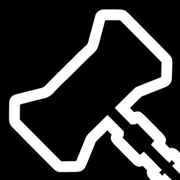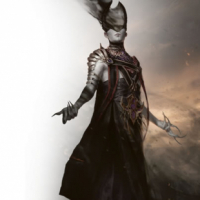My custom casual format called Generals
Those of you who have played this please help me explain.
Format group: constructed
Number of players: two, maybe more if you invest in a big floor. Can be played alone if two decks are used.
Deck size: exactly 20 cards + The army you start the game with.
Deck Building: Each player is allowed a deck with exactly 20 cards, which cannot have more than two of any card with the same English name that is not a basic land. You also get an army, which consists of fourteen common non-land, non-aura permanents and one planeswalker or creature that can be any rarity which is called the General. You may not have multiples of any card in your army.
The General: The General can only be removed from the battlefield by damage dealt to it by creatures. If a creature would damage a General, it gets Wither until the end of the combat. (It deals damage to creatures in the form of -1/-1 counters.)
How to win: You win by reducing your opponent's life total to zero or by removing their General from the battlefield.
Setup: Each player starts out with an amount of life equal to two times their General's toughness. All players have a starting hand of three cards. Find a large surface to play on and divide it among all the players. Each player then puts the creatures in their army onto their section of the battlefield. Your opponent's non-flying creatures must be able to get to your General.
Turn structure:
Untap step
Upkeep
Draw step
End step
Cleanup step
A combat may occur at any point in between the draw step and end step. At any point during your turn when a combat is not occuring but you are in between your draw and end steps, it is your main phase.
Moving creatures: Templates
You may only move two untapped creatures per turn. To do so, place an appropriate cutout so that the one end is touching the top of the card, then pick up the card and align the bottom of the card with the other end of the cutout. If part of your creature card is touching another creature card a combat starts and those creatures fight. (Unless your opponent's creature can't block your creature for some reason or your creature can't attack.) Notice that each cutout has a number on it, the higher the number the longer the cutout. What cut out your creature can use is affected by your creature's abilities and and toughness. A creature can only use a cutout with a number on it less than or equal to its toughness. The exclusions to this rule are creatures with haste, flying, and defender. A creature with haste or flying can always use the longest straight cutout and a creature with defender can only use the shortest cutouts of each shape. A creature without flying cannot go over an obstacle like a shoe or piece of furniture, but must instead go around it.
Tapping creatures: When you tap a creature, do not turn it as this affects movement, but instead put some sort of reminder on it.
Fighting: Fighting works in much the same way except for a few different things.
The creature(s) that are under the control of the player whose turn it is are the attacking creatures . The other creature(s) a involved are the defending creatures. A creature may only attack or block a creature it is touching. Creatures cannot attack players. If your creature for some reason can't attack but touches another creature during your turn, a combat does not start. A defending creature doesn't deal damage to the attacking creature if the defending creature can't block it. The attacking creature still deals damage to the defending creature.
Non-aura enchantments, artifacts, and lands: whenever you cast or play a land, non-aura enchantment, or artifact, put it somewhere in your section of the battlefield, which is established by the creature farthest away from your general that is under your control. If an opponent's creature touches a land, artifact or non-aura enchantment you control, they gain control of it and may move it somewhere within their section of the battlefield.
Format group: constructed
Number of players: two, maybe more if you invest in a big floor. Can be played alone if two decks are used.
Deck size: exactly 20 cards + The army you start the game with.
Deck Building: Each player is allowed a deck with exactly 20 cards, which cannot have more than two of any card with the same English name that is not a basic land. You also get an army, which consists of fourteen common non-land, non-aura permanents and one planeswalker or creature that can be any rarity which is called the General. You may not have multiples of any card in your army.
The General: The General can only be removed from the battlefield by damage dealt to it by creatures. If a creature would damage a General, it gets Wither until the end of the combat. (It deals damage to creatures in the form of -1/-1 counters.)
How to win: You win by reducing your opponent's life total to zero or by removing their General from the battlefield.
Setup: Each player starts out with an amount of life equal to two times their General's toughness. All players have a starting hand of three cards. Find a large surface to play on and divide it among all the players. Each player then puts the creatures in their army onto their section of the battlefield. Your opponent's non-flying creatures must be able to get to your General.
Turn structure:
Untap step
Upkeep
Draw step
End step
Cleanup step
A combat may occur at any point in between the draw step and end step. At any point during your turn when a combat is not occuring but you are in between your draw and end steps, it is your main phase.
Moving creatures: Templates
You may only move two untapped creatures per turn. To do so, place an appropriate cutout so that the one end is touching the top of the card, then pick up the card and align the bottom of the card with the other end of the cutout. If part of your creature card is touching another creature card a combat starts and those creatures fight. (Unless your opponent's creature can't block your creature for some reason or your creature can't attack.) Notice that each cutout has a number on it, the higher the number the longer the cutout. What cut out your creature can use is affected by your creature's abilities and and toughness. A creature can only use a cutout with a number on it less than or equal to its toughness. The exclusions to this rule are creatures with haste, flying, and defender. A creature with haste or flying can always use the longest straight cutout and a creature with defender can only use the shortest cutouts of each shape. A creature without flying cannot go over an obstacle like a shoe or piece of furniture, but must instead go around it.
Tapping creatures: When you tap a creature, do not turn it as this affects movement, but instead put some sort of reminder on it.
Fighting: Fighting works in much the same way except for a few different things.
The creature(s) that are under the control of the player whose turn it is are the attacking creatures . The other creature(s) a involved are the defending creatures. A creature may only attack or block a creature it is touching. Creatures cannot attack players. If your creature for some reason can't attack but touches another creature during your turn, a combat does not start. A defending creature doesn't deal damage to the attacking creature if the defending creature can't block it. The attacking creature still deals damage to the defending creature.
Non-aura enchantments, artifacts, and lands: whenever you cast or play a land, non-aura enchantment, or artifact, put it somewhere in your section of the battlefield, which is established by the creature farthest away from your general that is under your control. If an opponent's creature touches a land, artifact or non-aura enchantment you control, they gain control of it and may move it somewhere within their section of the battlefield.
This discussion has been closed.
 MTG Cardsmith Community Forums
MTG Cardsmith Community Forums
Comments